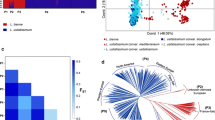Abstract
The domestication of cultivated flax (Linum usitatissimum L. subsp.usitatissimum) is briefly discussed.
Using data documented as a matter of routine in genebank work, 63 accessions of cultivated flax from the flax germplasm collection of the Gatersleben Genebank are compared with 73 accessions of its wild progenitor pale flax (subsp.angustifolium (Huds.) Thell.), which have been observed in systematic field trials. Range of variation, genetically based variation, heritability and correlation of several characters are considered, especially with respect to the influence of domestication.
Cultivated flax shows higher variation in the characters of generative plant parts, while pale flax varies more in the vegetative parts of the plant.
The character correlations are similar in both subspecies. Of the 29 characters studied in pale flax the parameters describing tillering, height of plant, weight of seeds, width of petals and width of leaves are especially suitable for distinguishing between different accessions. In spite of the high heritabilities of most of the characters, the influence of the environment is significant in most cases.
Similar content being viewed by others
References
Ascherson, P. & P. Graebner, 1913. Synopsis der Mitteleuropäischen Flora. Verlag von Wilhelm Engelmann, Leipzig und Berlin, Bd. 7.
Barnes, D.K., J.O. Culbertson & J.W. Lambert, 1960. Inheritance of seed and flower colors in flax. Agronomy Journal 52: 456–459.
Chandra, S. & P.O. Makhija, 1979. Genetic variability and interrelationships of some quantitive characters in geographical groups of exotic linseed (Linum usitatissimum L.) germ plasm, Acta agronomica academiae scientiarum Hungaricae 28: 65–70.
Dambroth, M. & R. Seehuber, 1988. Flachs; Züchtung, Anbau und Verarbeitung. Eugen Ulmer Verlag, Stuttgart.
Diederichsen, A., 1992. Variabilität bei Kulturform und Wildform von Lein,Linum usitatissimum L. Diplomarbeit im Fachbereich Agrarwissenschaften der Universität Göttingen, 77 p.
Dillman, A.C., 1936. Improvement in flax. In: USDA (Ed.), Yearbook of Agriculture. pp. 745–784.
Durrant, A., 1962. The environmental induction of heritable change inLinum. Heredity 17: 27–61.
Durrant, A. & O.J. Joarder, 1978. Regulation of hairless septa in flax genotrophs. Genetica 48: 171–183.
Fawzi, S., 1980. Flax. In: The history of medicinal and aromatic plants (Proceedings of the Second International Congress Alexandria, Egypt, December 1980). Hamdard Foundation Press, Karachi (Pakistan), pp. 97–99.
Gill, K.S. & D.M. Yermanos, 1967a. Cytogenetic studies on the genusLinum. I Hybrids among taxa with 15 as the haploid chromosome number. Crop Sci. 7: 623–627.
Gill, K.S. & D.M. Yermanos, 1967b. Cytogenetic studies on the genusLinum. II Hybrids among taxa with nine as the haploid chromosome number. Crop Sci. 7: 627–631.
Hammer, K., 1986. Linaceae. In: J. Schultze-Motel (Ed.), Rudolf Mansfelds Verzeichnis landwirtschaftlicher und gärtnerischer Kulturpflanzen, pp. 710-713. Akademie-Verlag, Berlin, Bd. 2.
Hammer, K., H. Knüpffer, G. Laghetti & P. Perrino, 1992. Seeds from the Past. A Catalogue of Crop Germplasm in South Italy and Sicily. Bari.
Hanelt, P. & R. Beridze, 1991. The flora of cultivated plants of the Georgian SSR and its genetic resources. Flora et vegetatio Mundi 9: 113–120.
Harlan, J.R., 1986. Plant domestication: Diffuse origins and diffusions. In: C. Barigozzi, (Ed.), The Origin and Domestication of Cultivated Plants, pp. 21–34. Elsevier Amsterdam-Oxford-New York-Tokyo.
Heer, O., 1872. Über den Flachs und die Flachskultur im Altertum. Neujahrsblatt der Naturforschenden Gesellschaft Zürich 74: 126.
Helbaek, H., 1959a. Notes on the evolution and history ofLinum. Kuml (Aarbog for jysk arkaeologisk selskab), pp. 103–129.
Helbaek, H., 1959b. Domestication of food plants in the Old World. Science 130: 365–372.
Hjelmquist, H., 1950. The flax weeds and the origin of cultivated flax. Bot. Notiser 1950: 257–298.
Kulpa, W. & S. Danert, 1962. Zur Systematik vonLinum usitatissimum L. Kulturpflanze (Beiheft 3): 341–388.
Lehmann, C. & K. Hammer, 1979. Bericht über die Reise nach Südwest-Spanien zur Sammlung kultivierter und wildwachsender Leguminosen im Jahre 1978. Kulturpflanze 27: 97–108.
Meusel, H., E. Jäger, S. Rauschert & E. Weinen, 1978. Vergleichende Chorologie der zentraleuropäischen Flora. Gustav Fischer Verlag, Jena, Band If (Text): 153.
Satapathi, D., R.C. Misra & B.S. Panda, 1987. Variability, correlation and path-coefficient analysis in linseed. Journal of Oilseeds Research 4: 28–34.
Schilling, E., 1944. Lein,Linum usitatissinum L. In: T. Roemer & W. Rudorf (Eds.), Handbuch der Pflanzenzüchtung. Paul Parey Verlag, Berlin, Bd. 4.
Schwanitz, F., 1960. Darwin und die Evolution der Kulturpflanzen. In G. Heberer & F. Schwanitz (Eds.), Hundert Jahre Evolutionsforschung. Gustav Fischer Verlag, Stuttgart.
Seetharam, A., 1972. Interspecific hybridization inLinum. Euphytica 21:489–495.
Tammes, T., 1911. Das Verhalten fluktuierend variierender Merkmale bei der Bastardisierung. Rec. des. trav. Bot. Neerl. 8: 201–288.
Tammes, T., 1923. Das genotypische Verhältnis zwischen wilden (sie!)Linum angustifolium und dem Kulturlein,Linum usitatissimum. Genetica 5: 61–76.
Tammes, T., 1933. Die Übereinstimmung zwischen Entwicklungsstadien und Phaenotypen verschiedener Genotypen. Genetica 15: 519–528.
UPOV, 1980. Richtlinien für die Durchführung der Prüfung auf Unterscheidbarkeit, Homogenität und Beständigkeit, Lein (Linum usitatissimum L.).
Utz, H.F., 1989. PLABSTAT Version 2d. Ein Computerprogramm zur statistischen Analyse von pflanzenzüchterischen Experimenten. Institut für Pflanzenzüchtung. Saatgutforschung und Populationsgenetik der Universität Hohenheim, Stuttgart.
van Zeist, W. & J.A.H. Bakker-Heeres, 1975. Evidence for linseed cultivation before 6000 bc. J. Archeol. Sci. 2: 215–219.
Vavilov, N.I., 1950. Selected writings of N.I. Vavilov. Translated by K. Starr Chester. Chronica Botanica 13.
Vavilov, N.I., 1957. World resources of cereals, grain leguminous crops and flax and their utilization in plant breeding (Russ.). Izdatel'stvo Akademii nauk SSSR, Moskov-Leningrad.
Vul'f, E.V. & E.V. Elladi, 1940. Familie Linaceae (D.C.) Dumort-Leingewächse (Russ.). In: E.V. Vul'f (Ed.), Kul'tumaja Flora SSSR (Faserpflanzen Teil 1). pp. 97–207. Moskov-Leningrad, Bd. 5.
Zeven, A.C., 1975. A possible contribution of environmentally induced changes to the domestication of plants. Euphytica 24: 369–370.
Zeven, A.C. & J.M.J. de Wet, 1982. Dictionary of Cultivated Plants and Their Regions of Diversity. Centre for Agricultural Publishing and Documentation, Wageningen.
Zohary, D. & M. Hopf, 1993. Domestication of Plants in the Old World. Clarendon Press, Oxford.
Author information
Authors and Affiliations
Rights and permissions
About this article
Cite this article
Diederichsen, A., Hammer, K. Variation of cultivated flax (Linum usitatissimum L. subsp.usitatissimum) and its wild progenitor pale flax (subsp.angustifolium (Huds.) Thell.). Genet Resour Crop Evol 42, 263–272 (1995). https://doi.org/10.1007/BF02431261
Received:
Accepted:
Issue Date:
DOI: https://doi.org/10.1007/BF02431261




